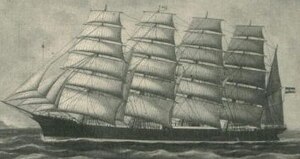Potosi (ship)
|
The Potosi under full sail
|
|
| History | |
|---|---|
| Name: | Potosi |
| Namesake: | City of Potosí in Bolivia |
| Owner: | F. Laeisz Shipping Company |
| Route: | Hamburg-Chile |
| Ordered: | 1894 |
| Builder: |
|
| Cost: | M 695,000.00 |
| Yard number: | 133 |
| Laid down: | November, 1894 |
| Launched: | June 8, 1895 |
| Christened: | June 8, 1895 |
| Commissioned: | July 26, 1895 |
| Maiden voyage: | July 26, 1895 to Iquique, Chile |
| Out of service: | 1914–1920 (WWI) |
| Renamed: | Flora (1923) |
| Homeport: | |
| Identification: |
|
| Fate: | Sold to Chile in 1923, caught fire on September 15, 1925 and sunk by the Argentine cruiser Patria on October 19, no loss of men |
| Status: | Wreck |
| Badge: | None; figurehead (river god or mountain spirit) |
| General characteristics | |
| Class and type: |
|
| Tonnage: | 4,027 GRT / 3,854 NRT |
| Displacement: | 8,350 ts (at 6,400 ts load) |
| Length: |
|
| Beam: | 49.7 ft (15.1 m) |
| Height: | |
| Draft: | 25.49 ft (7.77 m) |
| Depth: | 30.15 ft (9.19 m) (depth moulded) |
| Depth of hold: | 28.38 ft (8.65 m) |
| Decks: | 2 continuous steel, poop, midship, and forecastle decks |
| Deck clearance: | 8 ft (2.4 m) |
| Installed power: | No auxiliary propulsion; donky engine for sail winches, loading gear, pumps |
| Propulsion: | Sail |
| Sail plan: | 43 sails: 24 square sails, 12 staysails, 4 foresails, 3 spankers (56,510.53 sq ft / 5.250 m² [sq meters]) |
| Speed: | 19 knots (35 km/h) |
| Boats & landing craft carried: |
4 lifeboats |
| Capacity: | 6,400 ts load |
| Complement: | max. 44 |
| Crew: | Captain, 1st, 2nd, & 3rd mates, steward, 35-39 able seamen and shipboys |
Potosi was a five-masted steel barque built in 1895 by the German sailing ship company F. Laeisz as a trading vessel. As its shipping route was between Germany and Chile, it was designed to be capable of withstanding the rough weather encountered around Cape Horn.
Potosi was named after the eponymous Bolivian town of Potosí (the highest city in the world), the name beginning with "P" according to a Laeisz' tradition begun in the 1880s. The Potosi and sister ships became known as the Flying P Line and were described by Robert Carter as "without doubt, the most successful fleet of sail-driven ships ever assembled under one flag..."
Potosi had five masts and was rigged as a barque, meaning that the first four masts were square-rigged, each carrying six sails, and the fifth mast carried fore-and-aft-sails. She was the third windjammer in the world merchant fleet with that kind of rigging, after the France I of the Antoine-Dominique Bordes line of Bordeaux, and the first German (auxiliary) steel barque Maria Rickmers of the Rickmers line. In total, within the world merchant fleet, there were only six windjammers of this class of five-masted barque rigging, with four masts having carried six sails on each mast. The Potosi's sister ship, Preussen also had five masts, but was square rigged on each mast.
The idea of building such a ship for the Laeisz fleet came from the famous Laeisz-captain Robert Hilgendorf, who was to become the Potosi's first master. His considerations and ideas had a great influence on the ship's design and he was the supervising ship officer when the huge barque was under construction. She was assigned the call sign RKGB, and as with all P-liners her hull was black with a white waterline and a red underwater ship—the colours of the German flag at that time. Author Daniel S. Parrott describes the features of the "Flying P-Liners" and says "The effectiveness of the Flying P-Line lay not only in the construction of the vessel but also in their management." He also points out that "none of the four- or five-masted Laeisz ships ever foundered or was dismasted in a Cape Horn storm in the course of countless voyages."
...
Wikipedia

